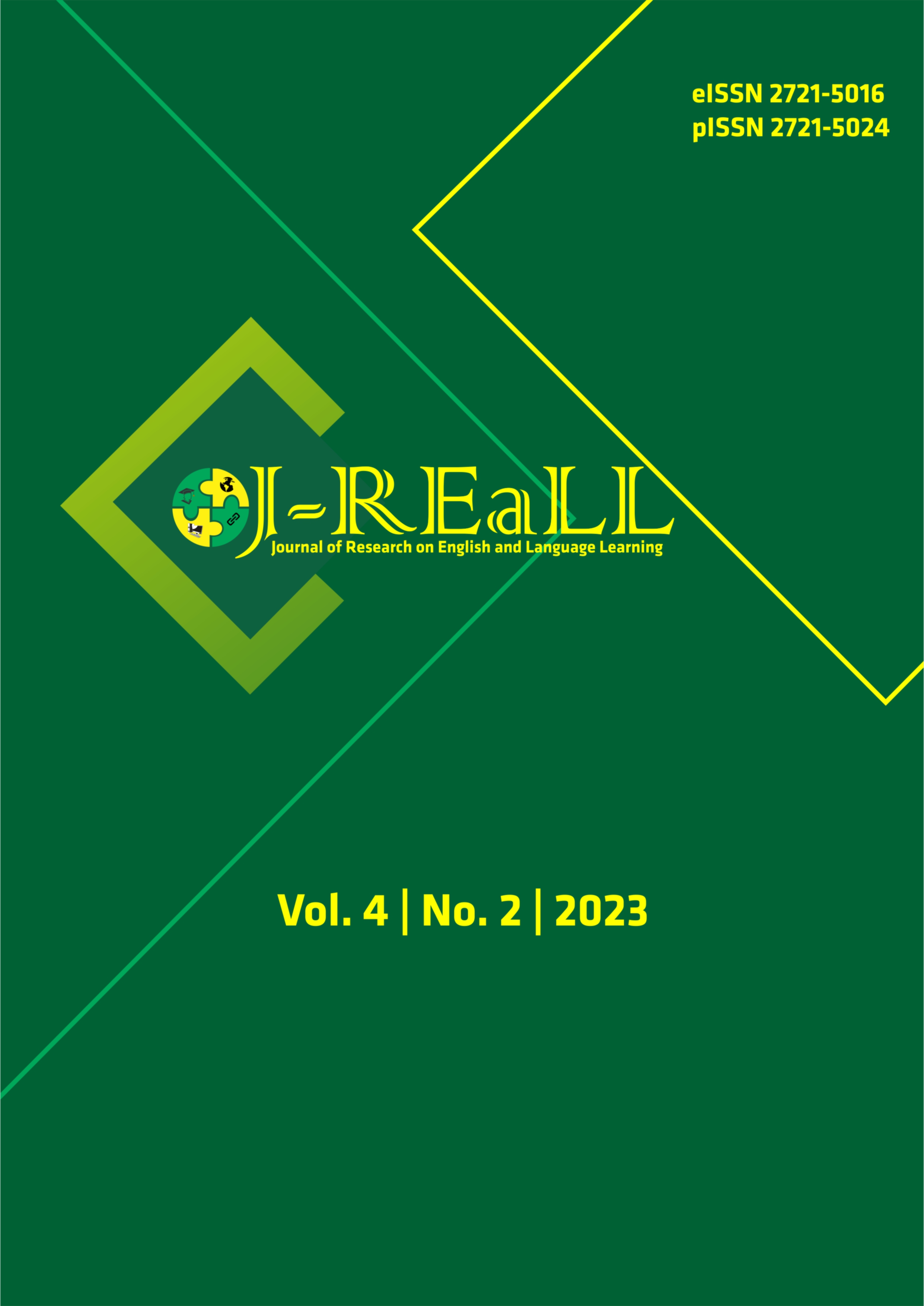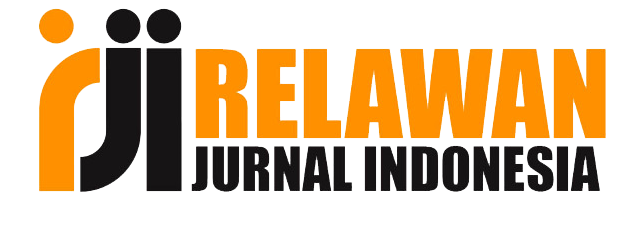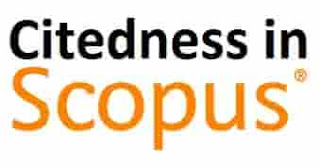Teacher readiness and understanding in implementing teaching English speaking skills using an ecological approach
DOI:
https://doi.org/10.33474/j-reall.v4i2.20095Keywords:
ecological approach, speaking skills, teacher readinessAbstract
The purpose of this research is to dig deeper into information about three vocational high schools teachers who have applied the ecological approach in their English teaching process. The ecological approach from the perspective of education is a learning approach that emphasizes contextual learning and focuses on the relationship between teachers, students, and the delivery of teaching materials. Applying the ecological approach to learning English at vocational high school can facilitate teachers in teaching English, especially learning English speaking for students. Teachers have an important role in education because a good education is influenced by teacher competence and teacher readiness in teaching. Speaking skills are one of the skills taught by teachers in schools, speaking skills in Indonesia do not receive enough attention, this is because students have not been able to communicate even in simple English. Based on this, the teacher's readiness to find an appropriate approach to the environmental conditions of students is very influential in teaching English speaking skills and an ecological approach can be a solution in improving students' English speaking skills. This research uses a qualitative research approach, and phenomenological as the research design. The participants in this study were English teachers in tenth grade from the three vocational high schools in Bandung district. This research shows that the ecological approach can improve student English speaking skills in three vocational high schools in Bandung district. It is caused by the teacher's activity who has applied the ecology approach indicator, namely coordination, internalization, media, and development.
References
Aji, W. N., & Setiyadi, D. B. P. (2020). Aplikasi Tik Tok sebagai media pembelajaran keterampilan bersastra. Metafora: Jurnal Pembelajaran Bahasa Dan Sastra, 6(1), 147–157.
Ambun, E. (2016). Peningkatan keterampilan berbicara bahasa Inggris melalui model pembelajaran aktif pada siswa kelas VII SMP Negeri 2 Sano Nggoang Kabupaten Manggarai Barat Tahun Pelajaran 2015/2016. Jurnal Ilmiah Mandala Education, 2(1), 103–113.
Asmin, A. I. (2019). Teachers’ strategies in teaching English at vocational high school. IDEAS: Journal on English Language Teaching and Learning, Linguistics and Literature, 7(2), 261–267. https://doi.org/10.24256/ideas.v7i2.1040
Asrida, D. (2017). Strategi mahasiswa untuk menghilangkan rasa cemas ketika berbicara bahasa inggris di kelas. IAIN Tulungagung Research Collections, 9(1), 27–40. https://doi.org/10.21274/ls.2017.9.1.27-40
Cahyadi, N., Rahim, A. R., Ernawati, E., Sukaris, S., Nisa, N. K., Kamil, A. T., & Rakhman, D. F. (2022). Pelatihan public speaking dalam peningkatan keberanian berbicara bahasa Inggris siswa kelas 10-11 MA Muhammadiyah Sidayu. DedikasiMU: Journal of Community Service, 4(2), 235–241. https://doi.org/http://dx.doi.org/10.30587/dedikasimu.v4i2.3997
Chairil Imran, M. (2022). Education, language, and culture (EDULEC) using BBC Web-based learning courses to improve vocational high school (VHS) students’ speaking skill. 1, 94–100. https://jurnal-eureka.com/index.php/edulecj%7C
Darmadi, H. (2010). Kemampuan dasar mengajar. In Bandung: Alfabeta (Vol. 114).
Daud, A., Aulia, A. F., & Ramayanti, N. (2019). Integrasi teknologi dalam pembelajaran: Upaya untuk beradaptasi dengan tantangan era digital dan revolusi industri 4.0. Unri Conference Series: Community Engagement, 1, 449–455. https://doi.org/https://doi.org/10.31258/unricsce.1.449-455
Esfandiari, R. (2015). An investigation into ESAP needs of Iranian BA students of law. Teaching English as a Second Language Quarterly (Formerly Journal of Teaching Language Skills), 34(3), 29–59.
Fraenkel, J. R., Wallen, N. E., & Hyun, H. H. (2012). How to design and evaluate research in education (Vol. 7). McGraw-hill New York.
Gudu, B. O. (2015). Teaching speaking skills in English language using classroom activities in secondary school level in eldoret municipality, Kenya. Journal of Education and Practice, 6(35), 55–63.
Guo, J. (2016). Research on the ecological model of English teaching. 2016 2nd International Conference on Social Science and Technology Education (ICSSTE 2016), 1050–1054.
Herwina, W. (2021). Optimalisasi Kebutuhan Siswa dan Hasil Belajar dengan Pembelajaran Berdiferensiasi. 2021. Perspektif Ilmu Pendidikan. 35 (2). 175-182. https://doi.org/http://doi.org/10.21009/PIP.352.10
Ihsan, M. D. (2016). Students’ motivation in speaking English. JEES (Journal of English Educators Society), 1(1), v1i1-147. https://doi.org/https://doi.org/10.21070/jees.v1i1.147
John, E., & Yunus, M. M. (2021). A systematic review of social media integration to teach speaking. Sustainability, 13(16), 9047.
Kuning, D. S. (2020). Applications of social media to learn speaking: Applications of social media to learn speaking. Edukasi Lingua Sastra, 18(1), 77–85. https://doi.org/https://doi.org/10.47637/elsa.v18i1.227
Lase, S. (2018). Hubungan antara motivasi dan kebiasaan belajar terhadap prestasi belajar matematika siswa smp. Jurnal Warta Edisi, 56, 1–829.
Marlina, M. (2019). Panduan pelaksanaan model pembelajaran berdiferensiasi di sekolah inklusif. http://repository.unp.ac.id/id/eprint/23547
Miftah, M. (2014). Pemanfaatan media pembelajaran untuk peningkatan kualitas belajar siswa. Kwangsan: Jurnal Teknologi Pendidikan, 2(1), 1–12. https://doi.org/https://doi.org/10.31800/jtp.kw.v2n1.p1--12
Miles, M.B, Huberman, A.M, & Saldana, J. (2014). Qualitative data analysis, A. Methods Sourcebook (Edition 3). Sage Publications.
Okri Ronaldo. (2016). Teaching material for English subject in vocational high school. Teaching Material for English Subject in Vocational High School, 4, 170–179. http://ejournal.unp.ac.id/index.php/selt/article/download/6974/5508
Resmini, S., Satriani, I., & Rafi, M. (2021). Pelatihan penggunaan aplikasi canva sebagai media pembuatan bahan ajar dalam pembelajaran bahasa inggris. Abdimas Siliwangi, 4(2), 335–343. https://doi.org/http://dx.doi.org/10.22460/as.v4i2p%25p.6859
Rooijakkers. (2003). Mengajar Dengan Sukses. Gramedia.
Syabrus, H. (2015). Kesiapan dalam pelaksanaan proses belajar mengajar sekolah menengah kejuruan Kota Pekanbaru. Jurnal Pendidikan Ekonomi Dan Bisnis, 7(1), 24–30.
Syamsinar. (2016). The problems in professional competence of teachers in teaching English subjet at vocational high schools. ETERNAL (English, Teaching, Learning and Research Journal), 1(1), 98–111. https://doi.org/10.24252/eternal.v11.2015.a5
Tambunsaribu, G., & Galingging, Y. (2021). Masalah yang dihadapi pelajar bahasa Inggris dalam memahami pelajaran bahasa Inggris. Dialektika: Jurnal Bahasa, Sastra Dan Budaya, 8(1), 30–41.
Tudor, I. (2003). Learning to live with complexity: Towards an ecological perspective on language teaching. System, 31(1), 1–12. https://doi.org/10.1016/S0346-251X(02)00070-2
Van Lier, L. (2010). The ecology of language learning: Practice to theory, theory to practice. Procedia - Social and Behavioral Sciences, 3(1), 2–6. https://doi.org/10.1016/j.sbspro.2010.07.005
Walsh, K. (2017). Self-directed learning at the point of care. InnovAiT, 10(3), 178–182. https://doi.org/https://doi.org/10.1177/1755738016679441
Downloads
Published
How to Cite
Issue
Section
License
Copyright (c) 2023 Riki Ruswandi, Muhammad Andriana Gaffar, Kikit Elisa Yuniarti

This work is licensed under a Creative Commons Attribution 4.0 International License.
Authors who publish this journal agree to the following terms:
- Authors retain copyright and grant the journal right of first publication with the work simultaneously licensed under a Creative Commons Attribution License that allows others to share the work with an acknowledgement of the work's authorship and initial publication in this journal.
- Authors can separately make additional contractual arrangements for non-exclusive distribution published by the journal (e.g., publish it in a book), with an acknowledgement of its initial publication in this journal.
- Authors are allowed and encouraged to send their work via online (e.g., in the institutional repositories or their website) after published by the journal.





















